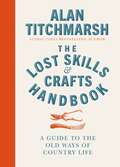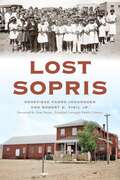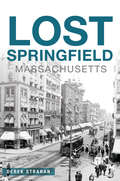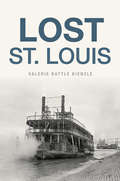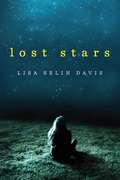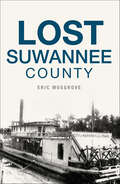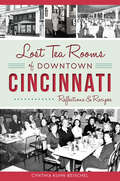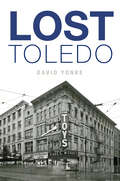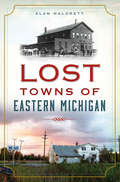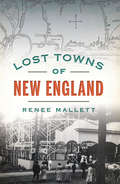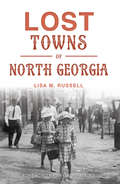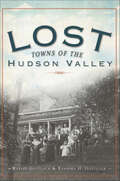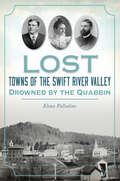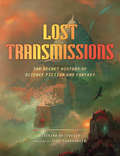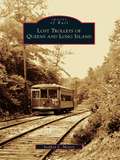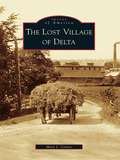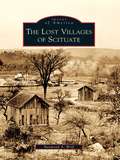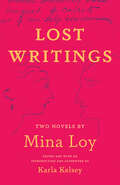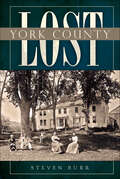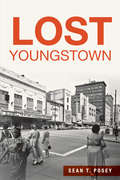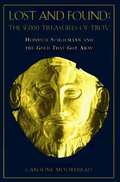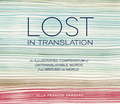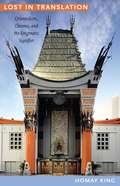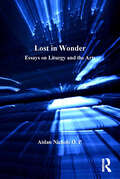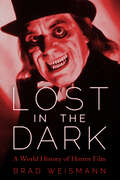- Table View
- List View
Lost Skills and Crafts Handbook
by Alan TitchmarshIn this inspirational and practical guide to country life, passionate and hugely knowledgeable countryman Alan Titchmarsh explores the heritage of rural Britain, its landscapes and wildlife, its traditions, customs and crafts. The Lost Skills and Crafts Handbook will help you rediscover your love of the countryside, including:- a checklist of British butterflies and where to find them- how to keep chickens, ducks, goats and sheep- how to make soap, candles and your own herbal remedies- how to track animals and forage for food- essential knot tying- how to build a campfire without matches- how to create a kitchen garden- the origins of country superstitionsAnd much more. With beautiful line art illustrations throughout, this compendium of the British countryside and its delights will be an essential read for any nature lover in your life.
Lost Sopris (Lost)
by Genevieve Johannsen Robert Daniel Vigil Jr.Before the Flood The lost town of Sopris lies silently beneath the depths of Trinidad Lake. Once a thriving mining community in the late 1800s, it was renowned for abundant coal deposits and a bustling population. Three generations called Sopris home. They fought in the Civil War, homesteaded and immigrated to work in the mines. Unfortunately, the town's fate took a drastic turn with the construction of the Trinidad Dam, which flooded the area and submerged the town. Authors Genevieve Faoro-Johannsen and Robert Daniel Vigil, Jr. preserve an enduring legacy of community and resilience through first-hand accounts, historic photos and never-before-seen maps.
Lost Springfield, Massachusetts (Lost)
by Derek StrahanAt the end of the nineteenth century, the U.S. Armory opened in Springfield, spurring rapid growth. With that golden age of progress came iconic buildings and landmarks that are now lost to time. Railroads brought workers eager to fill Springfield’s factories and enterprises like Smith & Wesson, Merriam Webster and Indian Motorcycles. The Massasoit House Hotel, the Church of the Unity and the Daniel B. Wesson mansion once served as symbols of the city’s grandeur. Forest Park grew into an upscale residential neighborhood of Victorian mansions. Join local historian Derek Strahan as he returns Springfield to its former glory, examining the people, events and—most importantly—places that helped shape the City of Firsts.
Lost St. Louis (Lost)
by Valerie Battle KienzleSt. Louis has been a shining beacon on the shores of the Mississippi River for more than 250 years, and many iconic landmarks have come and gone. The city hosted the World's Fair in 1904, with beautiful acres of buildings, gardens and fountains, nearly all of which are lost to time. Famous Busch Stadium now sits on an area that was once a vibrant community for Chinese immigrants. St. Louis Jockey Club was an expansive and popular gathering spot in the late nineteenth century until the state outlawed gambling. The Lion Gas Building was home to a unique mural featuring more than seventy shades of gray in tribute to famed aviator Charles Lindbergh. Author Valerie Battle Kienzle details the fantastic forgotten landmarks of St. Louis.
Lost Stars (A Broken Code #1)
by Lisa Selin DavisEleanor & Park meets Perks of Being a Wallflower in this bittersweet 1980’s story about love, loss, and a comet that only comes around every ninety-seven years. When Carrie looks through her telescope, the world makes sense. It’s life here on Earth that’s hard to decipher. Since her older sister, Ginny, died, Carrie has been floating in the orbit of Ginny’s friends, the cool kids, who are far more interested in bands and partying than science. Carrie’s reckless behavior crosses a line, and her father enrolls her in a summer work camp at a local state park. There, Carrie pulls weeds and endures pep talks about the power of hard work. Despite her best efforts to hate the job, Carrie actually feels happy out in nature. And when she meets Dean—warm, thoughtful, and perceptive—she starts to discover that her life can be like her beloved night sky, with black holes of grief for Ginny and dazzling meteors of joy from first love.
Lost Suwannee County (Lost)
by Eric MusgroveSuwannee County is filled with forgotten echoes of its lost past, from demolished pioneer homes to defunct railroads to lost forts from the Seminole Wars. In the 1830s, ecotourism arrived. Local sulfur springs, with their grand hotels and health resorts, drew travelers from around the world for a dip in the same healing waters of the Suwannee River traversed by steamboats. Thundering iron horses brought citizens and industry into the county, making Live Oak one of the largest cities in Florida in the early twentieth century. Landmarks and communities like the opulent Suwannee Springs resort and the once-flourishing riverbank town of Columbus disappeared in the face of progress. Lifelong resident and historian Eric Musgrove launches an entertaining and informative journey through Suwannee County's lost history.
Lost Tea Rooms of Downtown Cincinnati: Reflections & Recipes (American Palate)
by Cynthia Kuhn BeischelIt was a different time. Ladies wore gloves, hats and nice attire to luncheons at the Woman's Exchange. Shillito's provided a cosmopolitan environment for its patrons, while Mullane's was the perfect place to sip and socialize. The popular Good Morning Show radio program hosted by charming Bob Braun, and later Nick Clooney, was broadcast from McAlpin's Tea Room. Women gathered at Pogue's and Mabley & Carew tea rooms to celebrate birthdays, as well as wedding and baby showers, over dainty tea sandwiches. Author Cynthia Kuhn Beischel brings the Queen City's bygone downtown tea rooms back to life and shares more than one hundred beloved recipes.
Lost Toledo (Lost)
by David YonkeLook back at some of the beloved places and landmarks in Toledo's past, from stores and stadiums to neighborhoods and nightclubs. Recall the birth of the Jeep, as well as unique shopping experiences at Tiedtke's, Lasalle's, Lamson's and Portside Festival Marketplace. Catch the action of a Toledo Mud Hens game at bygone ballpark Swayne Field. Watch the glittering marquees light up the downtown skyline once again with the names of performers ranging from Count Basie and Elvis Presley to B.B. King and KISS. Author David Yonke jogs fond memories in this nostalgic stroll through Toledo's heritage.
Lost Towns of Eastern Michigan (Lost)
by Alan NaldrettMany of eastern Michigan's old boomtowns and sleepy villages are faded memories. Nature reclaimed the ruins of some while progress paved over the rest. Discover the stories of lost communities hidden in plain sight or just off the beaten track. The vanished religious colony of Ora Labora fell into a state of near-constant inebriation when beer became the only safe liquid to drink. Lake St. Clair swallowed up the unique currency of Belividere along with the place that issued it. Abandoned towns still crumble within Detroit's city limits. Alan Naldrett delves into the fascinating history of eastern Michigan's lost settlements.
Lost Towns of New England (Lost)
by Renee MallettNew England is home to abandoned towns and forgotten main streets that once bustled with life and commerce. From villages sunk underwater to cities undone by the rise and fall of mill life, madness or just plain bad luck, these ghost towns offer a unique look into the rich history of the past. Get a glimpse into what early life was really like through historical accounts of abandoned villages. Discover the history behind the ruins of towns like Connecticut's religious community Gay City, the former New Hampshire resort town of Unity Springs and Massachusetts's famed Dogtown--before nature reclaims them entirely. Join local author Renee Mallett as she uncovers the heydays of some of New England's most fascinating lost towns.
Lost Towns of North Georgia (Hidden History)
by Raymond Atkins Lisa M. RussellWhen the bustle of a city slows, towns dissolve into abandoned buildings or return to woods and crumble into the North Georgia clay. The remains of numerous towns dot the landscape--pockets of life that were lost to fire or drowned by the water of civic works projects. In 1832, Auraria was one of the sites of the original American gold rush. Cassville was a booming educational and cultural epicenter until 1864. Allatoona found its identity as a railroad town. Author and professor Lisa M. Russell unearths the forgotten towns of North Georgia.
Lost Towns of the Hudson Valley (Lost)
by Wesley GottlockDid you know a town can vanish? Discover the curious history of five towns nearly lost to history...This is the story of five towns located in New York's Hudson River Valley that met their demise as quickly as they were established. From the icehouses of Rockland Lake to the Ashokan Reservoir towns to the brick quarries of Roseton, only traces of these once vibrant settlements can now be found. Camp Shanks, one of World War II's most significant military compounds, was erected in 1942 but was quickly abandoned at the war's end. "Last Stop USA," as it was known, played host to over one million soldiers and welcomed patriotic visitors like Frank Sinatra and Shirley Temple. In this collection of images, local authors Wesley and Barbara Gottlock revive the spirits of these bygone communities and celebrate a lost way of life.
Lost Towns of the Swift River Valley: Drowned by the Quabbin (Lost)
by Elena PalladinoIn April 1938, Swift River Valley residents held a farewell ball to mark the demise of the quintessential New England town of Enfield and its three smaller neighbors, Greenwich, Dana, and Prescott. The Commonwealth of Massachusetts sacrificed these three towns to build the Quabbin, a massive reservoir of drinking water for residents of Boston. Three prominent residents attended the somber occasion. Marion Andrews Smith was the last surviving member of an important manufacturing family. Willard "Doc" Segur was the valley's beloved country doctor and town leader. And Edwin Henry Howe was Enfield's postmaster and general store proprietor. They helped build their beloved community for decades, only to watch grief-stricken as it was destroyed by 400 billion gallons of water. Author and historian Elena Palladino recounts the story of these communities as seen through eyes of those who lived there until the end.
Lost Transmissions: The Secret History of Science Fiction and Fantasy
by Desirina BoskovichThis illustrated journey through lost, overlooked, and uncompleted works is &“a fascinating enrichment of the history of sf and fantasy&” (Booklist). Science fiction and fantasy reign over popular culture now, associated in our mind with blockbuster movies and massive conventions. But there&’s much more to the story than the headline-making hits. Lost Transmissions is a rich trove of forgotten and unknown, imagined-but-never-finished, and under-appreciated-but-influential works from those imaginative genres, as well as little-known information about well-known properties. Divided into sections on Film & TV, Literature, Art, Music, Fashion, Architecture, and Pop Culture, the book examines: Jules Verne&’s lost novelAfroFuturism and Space DiscoE.T.&’s scary beginningsWilliam Gibson&’s never-filmed Aliens sequelWeezer&’s never-made space operathe 8,000-page metaphysical diary of Philip K. Dick, and more Featuring more than 150 photos, this insightful volume will become the bible of science fiction and fantasy&’s most interesting and least-known chapters. &“Will broaden your horizons and turn you on to wonders bubbling under the mass-market commodified pleasures to which we all too often limit ourselves.&” —The Washington Post
Lost Trolleys of Queens and Long Island (Images of Rail)
by Stephen L. MeyersAn amazing assortment of electric trolley lines once traversed the towns and villages of Queens and Long Island. With names like Jamaica Central, Northport Traction, Ocean Electric, and the Steinway lines, some meandered across meadows and hills while others sped over elevated tracks. There was even one line that had streetcars but no tracks. In the end, all of them helped stitch the countryside into the concentrated suburban area it is today--with barely a trace of the trolleys left anywhere.
Lost Village of Delta, The (Images of America)
by Mary J. CentroHome to a community of hardworking farmers and mill workers, the village of Delta stood along the banks of the Mohawk River until it was evacuated by the state to raise the water in the Erie Canal. Before the flooding of the river, Delta was a small country village with the same postmaster for over 30 years and families farming the same land for generations. In order to raise the water, the state approved the construction of five reservoirs across New York. The town was evacuated soon after, and the land that generations of residents toiled over now sits at the bottom of Lake Delta.
Lost Villages of Scituate, The (Images of America)
by Raymond A. WolfIn 1915, the general assembly appointed the Providence Water Supply Board to condemn 14,800 acres of land in rural Scituate. The hardworking people of the five villages were devastated. By December 1916, notices were delivered to the villagers stating that the homes and land they had owned for generations were to be taken and destroyed. Construction was well under way by 1921, and water was being stored by November 10, 1925. On September 30, 1926, the treatment plant began operation. It now serves more than 60 percent of Rhode Islanders. The $21 million project was the largest ever undertaken in the state at the time. The dam that annihilated the villages is 3,200 feet long and 100 feet high and holds back more than 40 billion gallons of water. Today these quiet villages lie up to 87 feet beneath the cold, dark waters of the Scituate Reservoir.
Lost Writings: Two Novels by Mina Loy
by Mina LoyTwo never-before-published novels by Mina Loy, the celebrated modernist poet, artist, and feminist Mina Loy (1882–1966) is an essential figure of the European and American modernist avant-garde. A groundbreaking writer of poetry, novels, essays, plays, and uncategorizable prose, she was also a fashion and lighting designer and an accomplished visual artist. As gallery agent for figures such as Giorgio de Chirico, Alberto Giacometti, and Salvador Dalí, she was a significant conduit for art that traversed the Atlantic. Loy has been best known for the poetry she published in the little magazines of the late teens and early twenties, most notably the long poem &“Songs to Joannes&” and the autobiographical verse-epic &“Anglo-Mongrels and the Rose.&” Featuring two never-before-published manuscripts of Loy&’s autobiographical prose—The Child and the Parent and Islands in the Air—this remarkable book expands Loy&’s rich oeuvre. Interlinked texts written over twenty years, from the 1930s to the 1950s, these fascinating works narrate the feminist struggle of the creative spirit as it comes into consciousness and encounters indoctrinating social norms. The works are accompanied by an introduction and afterword by Karla Kelsey that frame Loy as a poet, prose writer, businesswoman, and visual artist and discuss the texts, their stylistic innovations, and their unique interconnectedness.
Lost York County (Lost)
by Steven BurrOn October 17, 1947, a fire started near Newfield. It grew quickly and moved east, destroying Goose Rocks Beach, Fortune�s Rock and parts of Cape Porpoise. Thousands of historic buildings perished. The 1947 blaze was unique in the scope of its devastation, but fire has claimed countless York County landmarks over the years. Development projects, neglect and weather have doomed many more. Lost York County presents rare photos of many of these buildings, preserving the visual record of lost town halls, churches, schools, homes and hotels, from Kittery to Biddeford. In this collection of many never-before-seen images, Steven Burr offers a tribute to places and memories seized by time.
Lost Youngstown (Lost)
by Sean T. PoseyThe massive steel mills of Youngstown once fueled the economic boom of the Mahoning Valley. Movie patrons took in the latest flick at the ornate Paramount Theater, and mob bosses dressed to the nines for supper at the Colonial House. In 1977, the Youngstown Sheet and Tube Company announced the closure of its steelworks in a nearby city. The fallout of the ensuing mill shutdowns erased many of the city's beloved landmarks and neighborhoods. Students hurrying across a crowded campus tread on the foundations of the Elms Ballroom, where Duke Ellington once brought down the house. On the lower eastside, only broken buildings and the long-silent stacks of Republic Rubber remain. Urban explorer and historian Sean T. Posey navigates a disappearing cityscape to reveal a lost era of Youngstown.
Lost and Found: Heinrich Schliemann and the Gold That Got Away
by Caroline MooreheadIn this book, journalist and biographer Caroline Moore Head explores Schliemann's extraordinary life and tells how he contrived to smuggle part of the treasure from his dig in Asia Minor to his government in Berlin.
Lost in Translation
by Ella Frances SandersAn artistic collection of more than 50 drawings featuring unique, funny, and poignant foreign words that have no direct translation into English. Did you know that the Japanese language has a word to express the way sunlight filters through the leaves of trees? Or that there's a Finnish word for the distance a reindeer can travel before needing to rest? Lost in Translation brings to life more than fifty words that don't have direct English translations with charming illustrations of their tender, poignant, and humorous definitions. Often these words provide insight into the cultures they come from, such as the Brazilian Portuguese word for running your fingers through a lover's hair, the Italian word for being moved to tears by a story, or the Swedish word for a third cup of coffee. In this clever and beautifully rendered exploration of the subtleties of communication, you'll find new ways to express yourself while getting lost in the artistry of imperfect translation.From the Hardcover edition..From the Hardcover edition.
Lost in Translation: Orientalism, Cinema, and the Enigmatic Signifier
by Homay KingIn a nuanced exploration of how Western cinema has represented East Asia as a space of radical indecipherability, Homay King traces the long-standing association of the Orient with the enigmatic. The fantasy of an inscrutable East, she argues, is not merely a side note to film history, but rather a kernel of otherness that has shaped Hollywood cinema at its core. Through close readings of The Lady from Shanghai, Chinatown, Blade Runner, Lost in Translation, and other films, she develops a theory of the "Shanghai gesture," a trope whereby orientalist curios and dcor become saturated with mystery. These objects and signs come to bear the burden of explanation for riddles that escape the Western protagonist or cannot be otherwise resolved by the plot. Turning to visual texts from outside Hollywood which actively grapple with the association of the East and the unintelligible--such as Michelangelo Antonioni's Chung Kuo: Cina, Wim Wenders's Notebook on Cities and Clothes, and Sophie Calle's Exquisite Pain--King suggests alternatives to the paranoid logic of the Shanghai gesture. She argues for the development of a process of cultural "de-translation" aimed at both untangling the psychic enigmas prompting the initial desire to separate the familiar from the foreign, and heightening attentiveness to the internal alterities underlying Western subjectivity.
Lost in Wonder: Essays on Liturgy and the Arts
by Aidan Nichols P.This book explores the Liturgy as the manifestation by cultic signs of Christian revelation, the 'setting' of the Liturgy in terms of architectural space, iconography and music, and the poetic response which the revelation the Liturgy carries can produce. The conclusion offers a synthetic statement of the unity of religion, cosmology and art. Aidan Nichols makes the case for Christianity's capacity to inspire high culture - both in principle and through well-chosen historical examples which draw on the best in Catholicism, Eastern Orthodoxy and Anglicanism.
Lost in the Dark: A World History of Horror Film
by Brad WeismannTwo horror films were nominated for the Academy Award for Best Picture in 2018, and one of them—The Shape of Water—won. Since 1990, the production of horror films has risen exponentially worldwide, and in 2013, horror films earned an estimated $400 million in ticket sales. Horror has long been the most popular film genre, and more horror movies have been made than any other kind. We need them. We need to be scared, to test ourselves, laugh inappropriately, scream, and flinch. We need to get through them and come out, blinking, still in one piece. Lost in the Dark: A World History of Horror Film is a straightforward history written for the general reader and student that can serve as a comprehensive reference work. The volume provides a general introduction to the genre, serves as a guidebook to its film highlights, and celebrates its practitioners, trends, and stories. Starting with silent-era horror films and ending with 2020’s The Invisible Man, Lost in the Dark looks at decades of horror movies. Author Brad Weismann covers such topics as the roots of horror in literature and art, monster movies, B-movies, the destruction of the American censorship system, international horror, torture porn, zombies, horror comedies, horror in the new millennium, and critical reception of modern horror. A sweeping survey that doesn’t scrimp on details, Lost in the Dark is sure to satisfy both the curious and the completist.
